Goeppertia insignis (aka Calathea insignis)
With its long leaves and striking pattern, rattlesnake plant should be an essential member of your prayer plant collection.
What? You don’t have a prayer plant collection? What a feat of restraint!
While I admittedly lack such restraint, I think it’s a fair trade. Because of my zealousness for this family of flora, I have a group of beautiful Marantaceae plants, and my rattlesnake calatheas are some of my absolute favorites.
This is one snake that definitely won’t bite you – but its beguiling foliage might steal your heart!
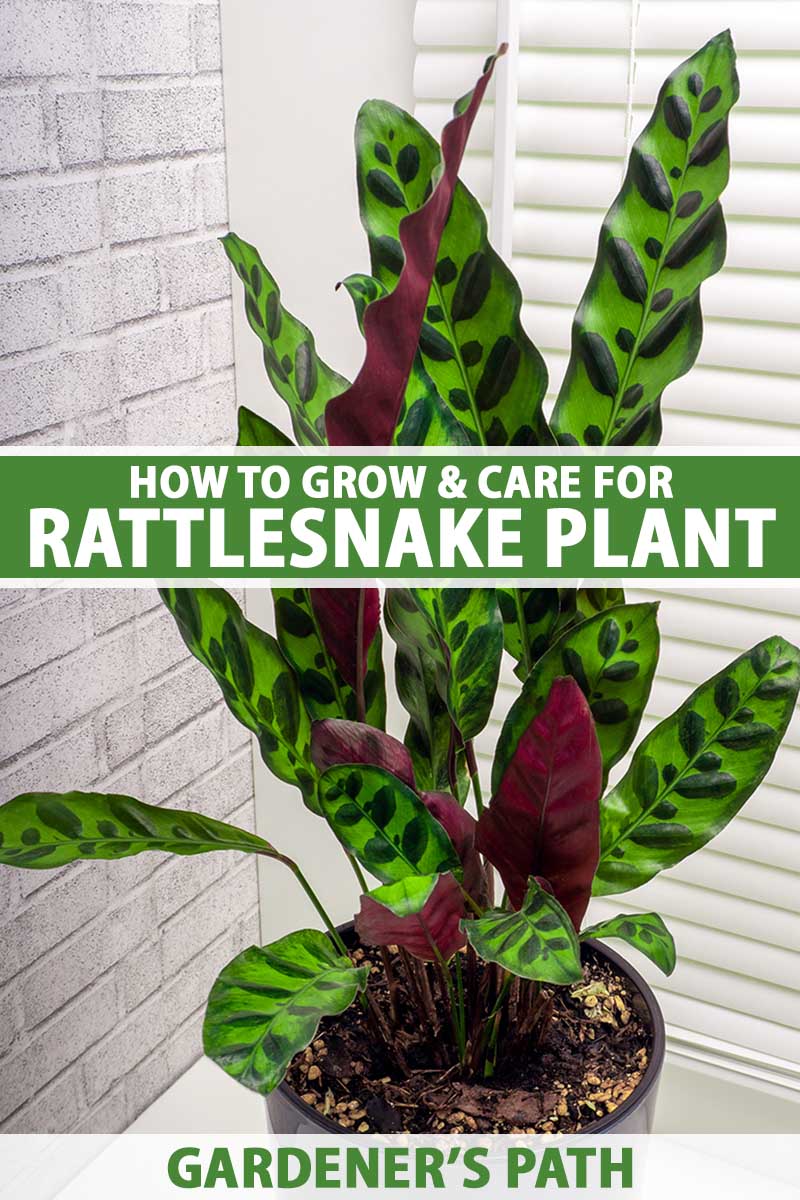
We link to vendors to help you find relevant products. If you buy from one of our links, we may earn a commission.
Whether you are adding it to a collection of prayer plants or if this is your first Marantaceae specimen, I’ll share everything you need to know to grow and care for this species.
Here’s what we’ll cover:
What You’ll Learn
While we’ll be focusing on just one species for this article, if you’re interested in more general care guidance for prayer plants, be sure to check out our complete guide.
And just to make sure we’re all on the same page, this article is about the species commonly used as a houseplant, and not Eryngium yuccifolium.
This species goes by the common name “rattlesnake master,” and it is a deciduous perennial with thistle-like flower heads that grows natively in the Eastern and Midwestern United States.
The subject of our article may also be confused with rattlesnake ginger (Calathea crotalifera) from the same family, the Marantaceae.
This is a species grown for its large, showy, yellow flowers, and whose large, oval-shaped, green leaves are not patterned. With this other calathea, the “rattlesnake” moniker refers to the rattle shape of its inflorescence.
What Is a Rattlesnake Plant?
Rattlesnake plant is a tropical, evergreen, herbaceous perennial that has long, smooth, glossy leaves, which are lance-shaped and have distinctive markings.
It’s both the long shape of the leaves and their pattern that give this calathea a reptilian allure.
The leaves are light green with a pattern of dark green splotches that alternate from large to small, located between the mid-rib and the leaf margin. This pattern of dark splotches gives the illusion of small leaflets.
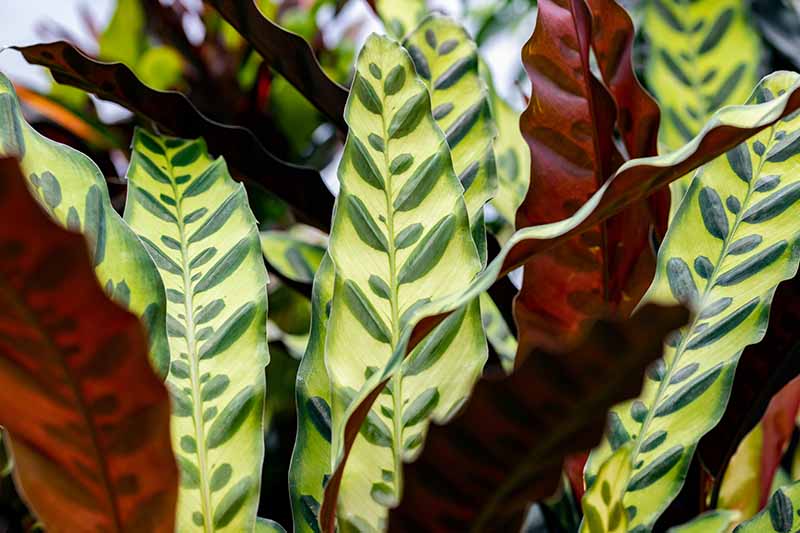
Slightly wavy, especially at the margins, the leaves are also rimmed with dark green. They have purple to burgundy undersides, which are even more noticeable when the plant raises its leaves after nightfall.
Rattlesnake calathea grows to be up to three feet tall by three feet wide and has a fountain-like growth habit. It has no main stem; instead, each individual leaf petiole emerges from rhizomes in the soil.
New leaves also emerge from rhizomes, rolled up tightly, and showing their purple undersides as they slowly unfurl.
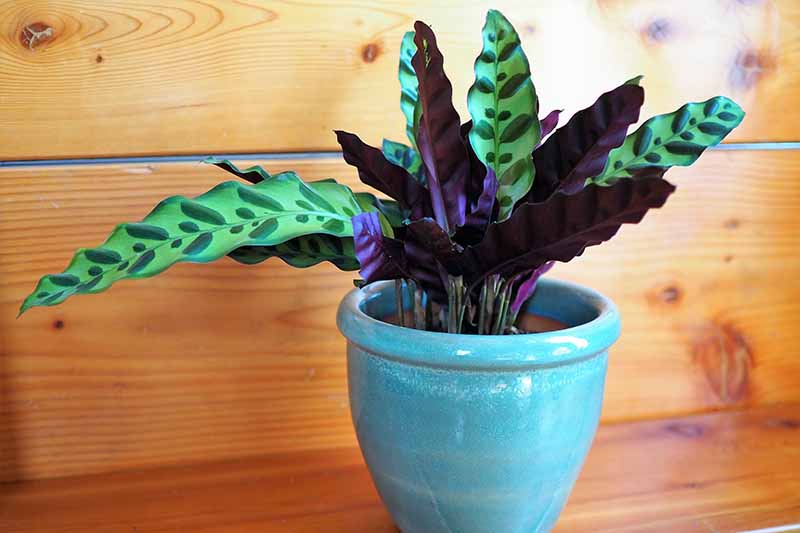
When plants produce flowers, these emerge on short stems at the base of the plant. They are white in color and medium-sized. However, flowering on specimens grown indoors is rare.
Like its other prayer plant relatives, one of the fascinating features of this species is that it raises and lowers its leaves to the rhythms of nightfall and sunrise.
At night you’ll notice more purple among your houseplant’s foliage, as it lifts its leaves up vertically, revealing their undersides.
In the morning, you’ll see this calathea gradually lower its leaves again to a more horizontal position, placing its green pattern in fuller view.
Cultivation and History
This species is a native to the State of Rio de Janeiro in southeast Brazil, where it grows in dappled shade in humid tropical forests as an understory plant.
Goeppertia insignis is a member of the prayer plant family or Marantaceae, and counts such beauties as Stromanthe thalia ‘Triostar,’ zebra calathea, pinstripe plant, peacock plant, and red-veined maranta among its relatives.
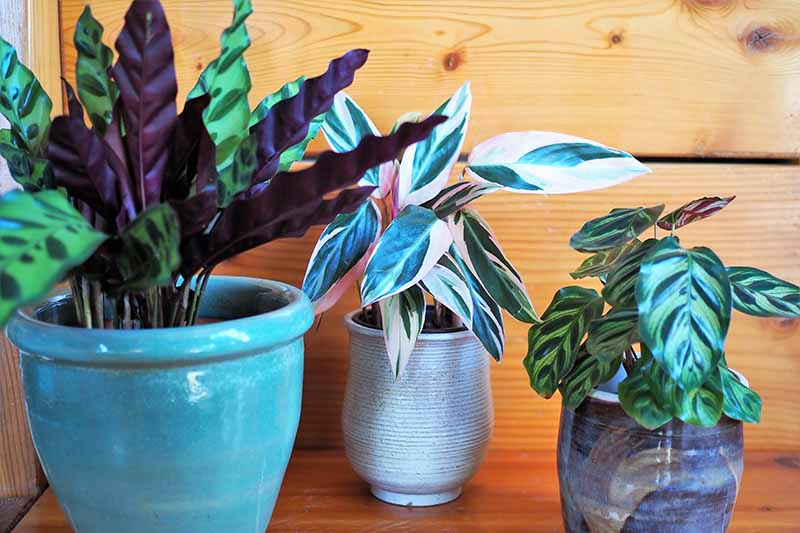
Previously classified in the Calathea genus, this species and most of its calathea relatives were reclassified taxonomically to a different genus, Goeppertia, in 2012.
However, this species is still commonly referred to as Calathea insignis. Its Goeppertia nomenclature hasn’t quite caught on yet – either among home gardeners or in scientific circles!
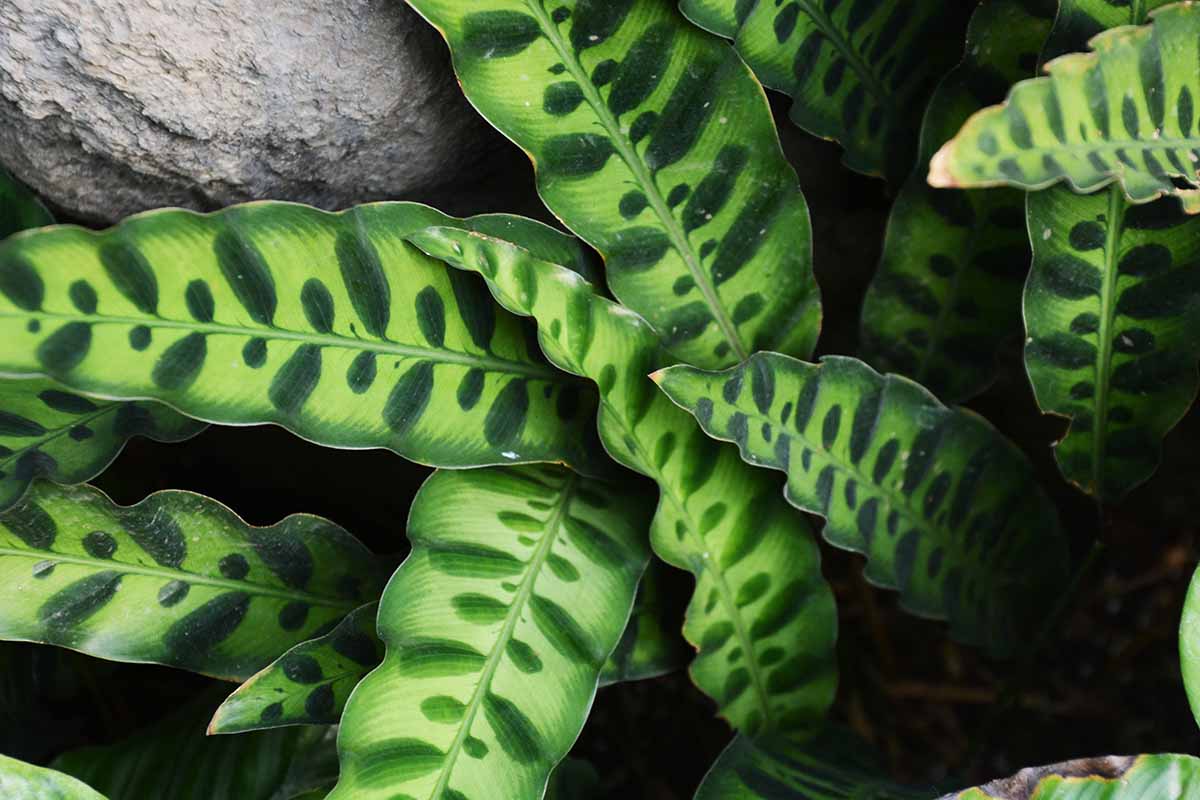
Even before being reclassified, this species was also sometimes referred to by an older classification, C. lancifolia. Some sources continue to use other old classifications including G. lancifolia and Maranta insignis.
Its species name insignis means “distinguished,” while the genus name Goeppertia honors Heinrich Goeppert, a German botanist.
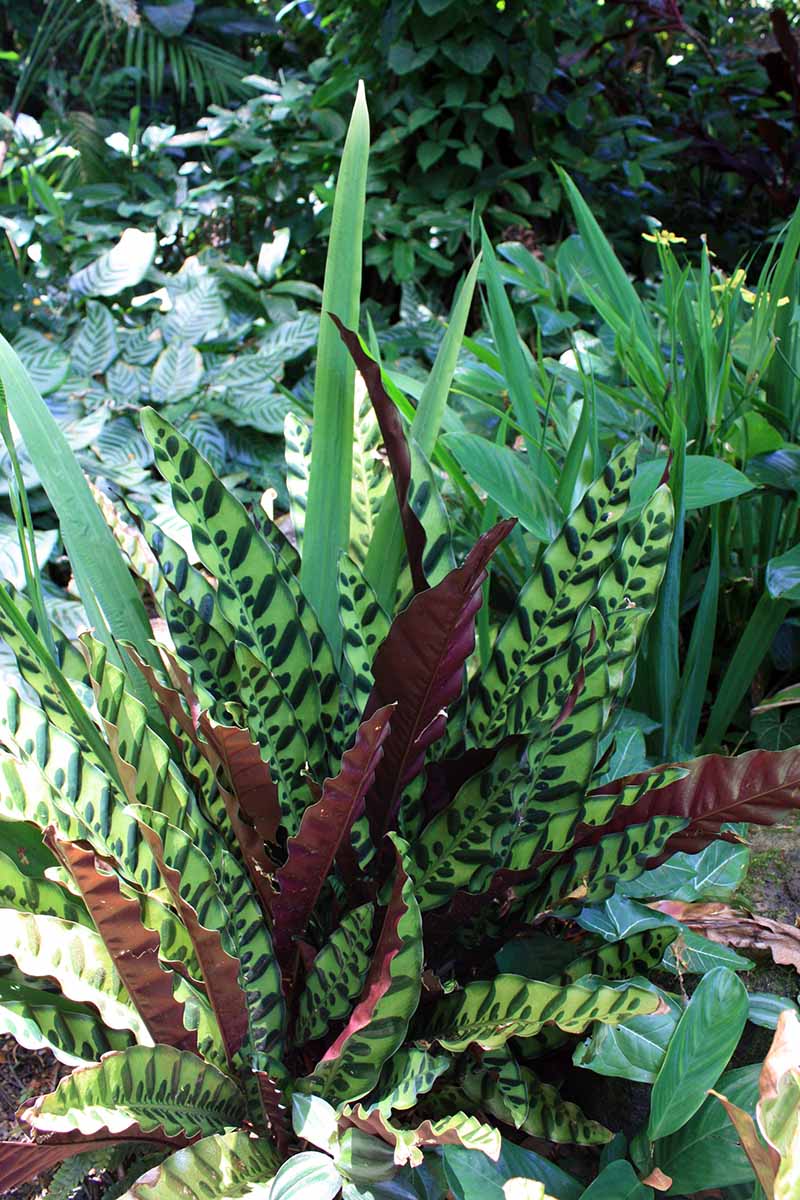
While this species is primarily known for its use as a houseplant, it can be grown outdoors year-round in USDA Hardiness Zones 10a to 12.
You can also count G. insignis as one of the nontoxic houseplant options that’s suited for use in homes with pets or small children.
Propagation
Since calathea seeds are hard to source and difficult to propagate, rattlesnake calatheas are best propagated through division.
Towards the end of winter or in early spring, you’ll probably notice new leaves unfurling from your plant. This is a suitable time to undertake propagation.
Inspect the stems of your calathea – if you can make out several different clumps, you can divide your specimen into several different plants. You may also notice an offshoot coming up and away from the main clump of stems.
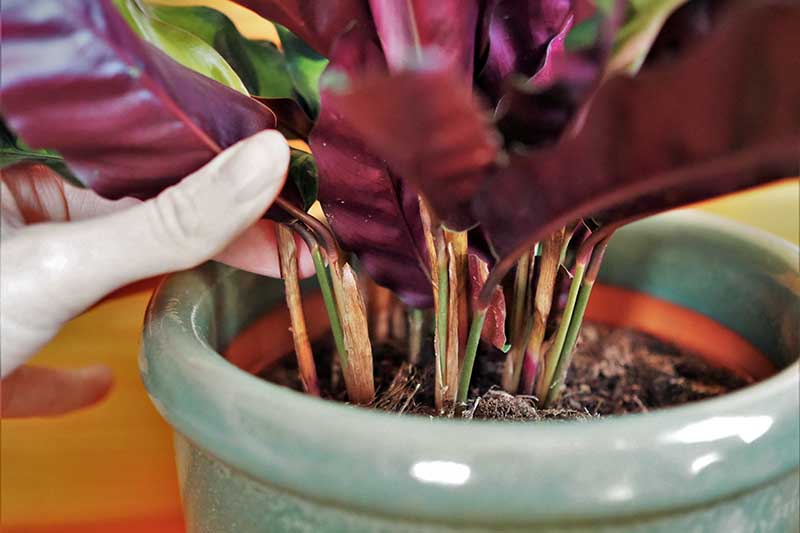
First decide how many divisions you want to make from your parent plant, but try to make sure that each division has at least three leaves on it.
Gather your repotting supplies, including clean pots, growing medium, and a sharp knife or pair of pruners – make sure they are sterilized.
Gently work apart the different clumps from each other, using your knife or scissors if needed, and then repot the clumps as indicated in the repotting section below. Keep reading to learn more.
How to Grow Rattlesnake Plants
While rattlesnake calathea isn’t exactly a low-maintenance plant, it’s not hard to keep it happy if you provide it with its basic care requirements:
Choosing a Plant
The first step to success in your calathea growing adventure is to choose a healthy specimen.
Avoid wilting plants or those with yellowing or brown leaves.
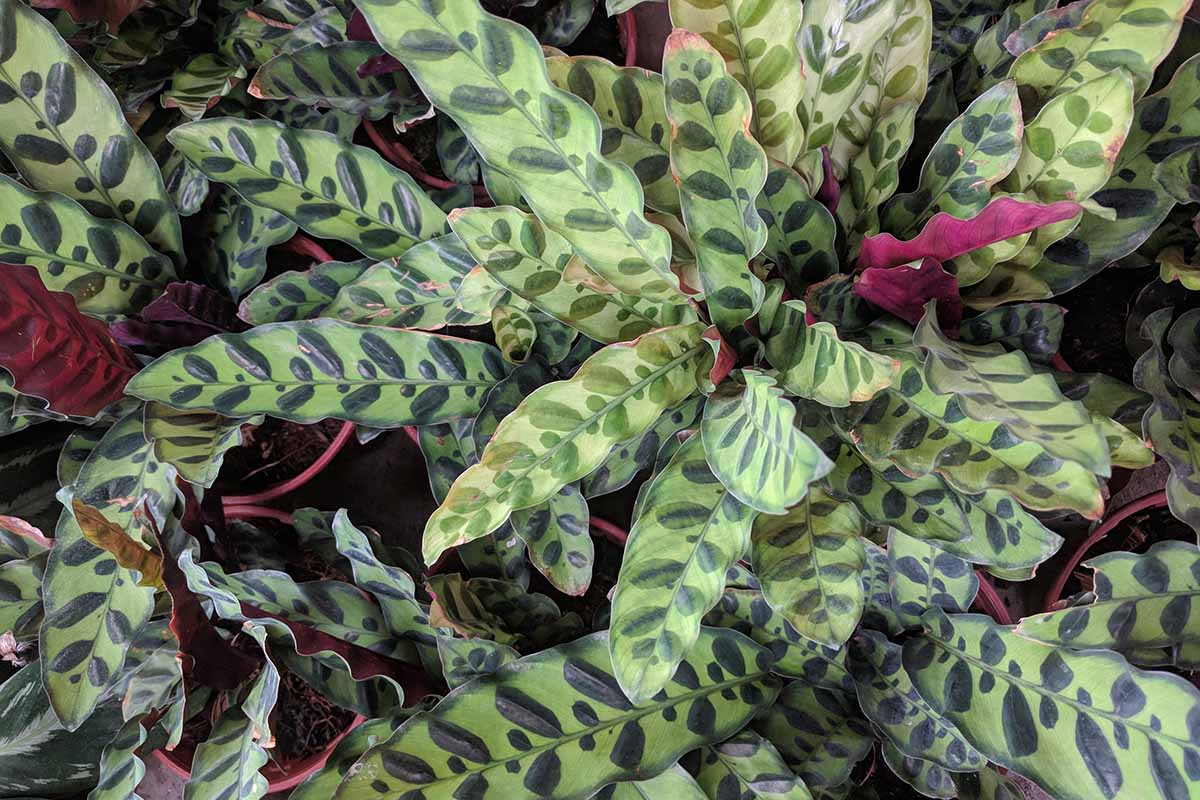
Also, look for signs of disease and pest infestation, and firmly reject any such specimens – unless, of course, you have a strong urge to be a houseplant rehabilitator, as well as an area where you can quarantine the specimen until it is in good health.
You’ll learn more about checking for pests and signs of disease later in this article.
Light
A native of shady tropical forests, rattlesnake calathea does best in medium, indirect light.
This houseplant will tolerate a small amount of direct sun early in the morning, but avoid direct midday or afternoon sun.
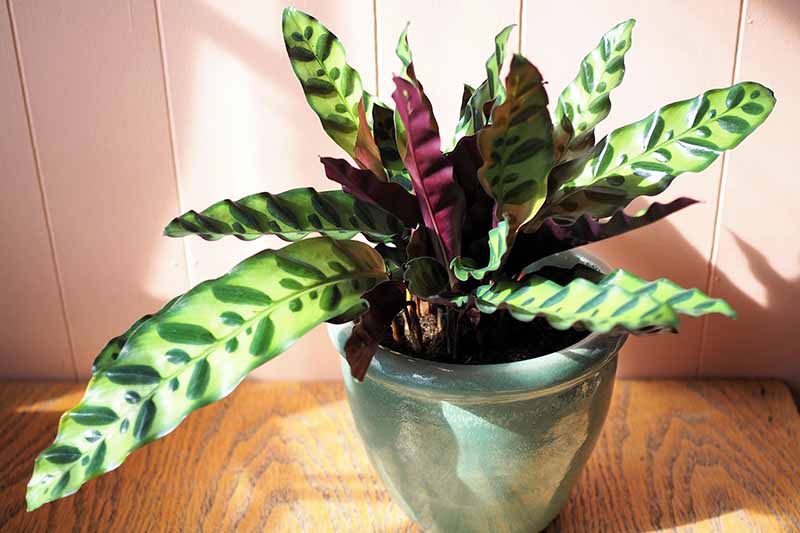
If exposed to too much direct sun, its leaves risk being scorched, and they may lose their striking patterns as well.
This species can adapt to low, indirect light, but will grow more slowly in such conditions.
Temperature
G. insignis prefers a moderate temperature without any extremes. For best results, keep this species in a temperature range between 65 and 75°F.
Situate it in a location where it will be spared from both cold drafts, such as what you’ll find near windows and exterior doors, and hot air, such as near central heating air vents.
This prayer plant is not as tolerant of high heat temperatures as some of its relatives.
If you must expose your houseplant to excessively hot conditions during summer, water it more frequently and move it to the shadiest side of your home to keep it cooler.
Water
Like its relatives, G. insignis benefits from regular watering, and prefers to have moist – but not soggy – soil.
Be sure to use rainwater, distilled water, or filtered water since this species doesn’t tolerate impurities such as fluoride that can be found in tap water.
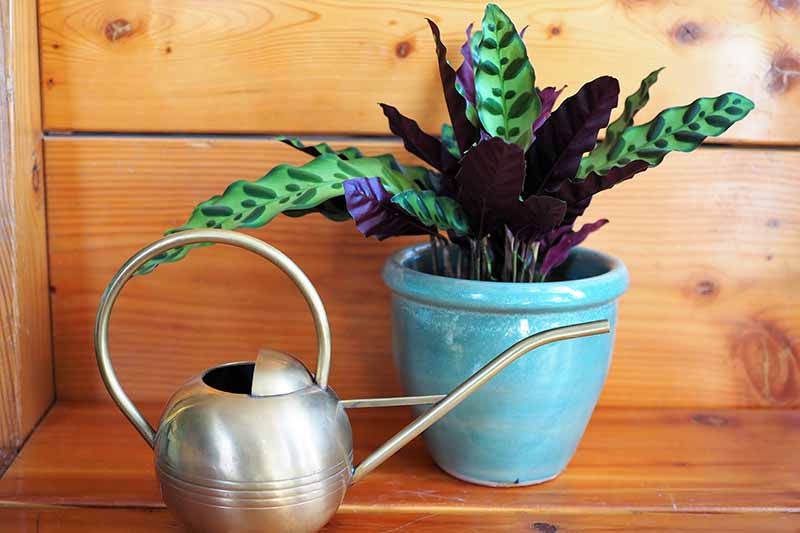
When watering, remove your houseplant from its decorative pot and place it in a bowl, sink, or bathtub. Water the surface of its soil evenly – this will be easier with a watering can adapted for houseplants.
Water until liquid runs from the bottom of the pot. I like to repeat this process twice during my weekly watering routine.
Let the pot drain thoroughly before returning it to its decorative pot or saucer.
You might also want to try the bottom watering method with this houseplant.
Humidity
Like its prayer plant relatives, G. insignis prefers humid growing conditions, with a relative humidity of at least 50 percent.
If you live in a humid climate, you may not need to take any further measures to provide this plant with the moist air it prefers.
However, if you heat your home in winter, or live in a more arid climate, there are many ways you can increase the relative humidity for your specimen.
One method is to place your calathea on a humidity tray.
You can make your own humidity tray by filling a dish with pebbles and water, and allowing the houseplant to sit on the pebbles, above the water level – just be careful to avoid letting the plant wick up water through its pot.

7” x 9” Humidity Tray with Polished Pebbles
If this DIY method isn’t at the top of your to-do list, you can purchase a ready-made humidity tray that comes with pebbles, such as this seven-by-nine-inch model available for purchase from 9GreenBox via Amazon.
Another option for increasing relative humidity for your calathea is to group it with other houseplants to create a more humid microclimate.
In addition to grouping houseplants, smaller specimens can be placed inside terrariums, such as this mini greenhouse from Ikea, available via Amazon.

Finally, if your specimen is too large to place in a terrarium or mini-greenhouse, you might also consider using a humidifier near your calathea to help humidify the air.
Providing adequate humidity will go a long way toward preventing brown leaf tips or edges on your calathea.
While a lack of sufficient humidity is probably the most common reason for brown tips, there are other causes as well. You can learn about the top reasons for brown leaves on prayer plants in our article.
Soil
One of the trickiest aspects of growing prayer plants is finding a really good potting medium.
By now you know that G. insignis likes to have moist soil, and what’s usually recommended to ensure such moist soil is a peaty growing medium. But there’s a caveat – prayer plants also need good drainage.
In addition to these requirements, it’s best if this houseplant’s growing medium does not contain perlite in order to avoid exposure to fluoride, which can cause tip burn.
And as far as pH goes, this species is fairly flexible and can grow in soil that is slightly acidic to slightly alkaline, or in other words, in soil with a pH ranging between 6.1 and 7.3.
Research also shows that compost, biochar, and humic acid all contribute to good growth for this particular species.
Combining these various requirements and considerations, the peat-free calathea potting medium I reach for is one part coconut coir and one part De La Tank’s Houseplant Soil Mix for houseplants.
The coconut coir provides the peaty water retention, while De La Tank’s Houseplant Soil Mix brings with it good drainage from pumice and chunky coconut husks, as well as compost, biochar, and humic acid, all of which will help this species flourish.
You can find De La Tank’s Soil Mix in one-, eight-, or 16-quart bags from Tank’s Green Stuff via Arbico Organics.
As for the coconut coir (also known as cocopeat), buying this product in a compressed form makes it more efficient to store and keep on hand for various gardening uses.
10-lb Prococo Compressed Coconut Coir Block
I like this 10-pound block of compressed coconut coir from Prococo, also available via Arbico Organics.
Growing Tips
- Provide medium, indirect light.
- Keep soil moist but not soggy and provide good drainage.
- Avoid drafts and temperature extremes.
Pruning and Maintenance
Rattlesnake calatheas don’t require much additional maintenance once their basic requirements are met. However, here are a few other tips that will help keep your houseplant happy and healthy:
Pruning
Despite our best efforts, prayer plants like G. insignis are prone to browning leaf tips and edges. If you find these unsightly, you can trim them off.
Any leaves that go brown due to missed waterings won’t ever recover their green hue, though new ones will emerge looking fresh and green as long as any neglect is remedied.
To prune any unwanted leaves, first sterilize a pair of scissors or garden snips by wiping them down with rubbing alcohol or hydrogen peroxide.
Trim the brown part, or if a whole leaf needs to be removed, make your cut as far down the leaf stem as possible.
Fertilizing
When fertilizing prayer plants, make sure to take a gentle approach.
I use worm compost tea for mine. If you don’t yet have a vermicompost bin set up in your home, you can purchase worm compost tea bags from the Earthworm Technologies Store, via Amazon.

Teadrops All Purpose Houseplant Fertilizer
These sachets are soaked in room-temperature water, and then served up as a fertilizer to your houseplant at watering time. Be sure to follow the manufacturer’s instructions.
Cleaning Leaves
When you water your houseplant, take advantage of this moment to give your calathea’s foliage a light cleaning.
You can accomplish this with just a paper towel or clean rag and some water.

Dampen the paper towel, then wipe down the tops and bottoms of each leaf.
This will help to remove any dust that has built up on your houseplant’s foliage and keep it not just looking great, but feeling healthy as well, since dust can clog a plant’s stomata.
Repotting
Since calatheas are slow-growing, they don’t need to be repotted very frequently – every two or three years should work in most cases.
But rather than scheduling a hard date with your bag of potting soil and sticking to it, observe your calathea and let it tell you when it needs to be repotted.
If you have to water two or three times a week to keep it from drying out, then it’s probably time to undertake this task!
Beyond that, the best time to repot is in spring when you see new growth on your calathea.
Another good tip is to wait until the day after you’ve watered your houseplant.
When it seems that it is indeed time to transition your houseplant to a new container, gather your repotting supplies.
You’ll need a pot that’s just one size larger than your current pot, potting medium, and a work surface you don’t mind getting a little dirty – I like to use a cookie sheet.
Remove the plant from its pot and rub your hand along the edge of the soil to loosen up its roots.
Place a little soil in the bottom of the new pot. Situate your plant in its new pot, adjusting the amount of soil in the bottom of the pot if needed, so you leave just half an inch to an inch of space between the top of the soil and the rim of the pot.
Fill in with potting medium, taking care not to cover the crown of the plant (the part where its stems emerge from the soil). Tap the pot gently on the work surface to settle in the soil, and add more growing medium if needed.
Water in your newly repotted houseplant and return it to its usual location.
Where to Buy Rattlesnake Plants
Rattlesnake calatheas are slow-growing plants, so when you’re ready to add one to your houseplant collection, choose a size that you will be happy with for a while.
Small
If you’re planning to keep your houseplant in a terrarium, choose a small specimen in a three- or four-inch pot.
Live Starter Rattlesnake Plant in 4” Pot
You’ll find a small starter C. insignis available for purchase in a four-inch pot from Hirt’s Gardens, via Amazon.
Medium
If you’d like your calathea companion to create a nice presence on a side table next to your sofa or at your workstation, a medium-sized specimen will work well, so look for one in a six-inch pot.
Live Mid-Sized Rattlesnake Calathea
A live plant in a six-inch pot can be found for purchase from Fast Growing Trees.
Large
If you are looking for a calathea large enough to hold its own as a floor specimen, look for one in an eight-inch pot.
Live Mature Rattlesnake Plant in 8”-Pot
You can purchase a mature, live plant in an eight-inch pot from the Wekiva Foliage via Amazon.
Managing Pests and Disease
Rattlesnake calathea is easygoing when it comes to pests and diseases – this species isn’t particularly prone to such problems.
However, here’s what you’ll want to look for, particularly when welcoming a new plant into your home:
Insects
If you have recently purchased a new specimen or have summered your houseplants out of doors, keep a lookout for these pests:
Mealybugs
You’ll probably spot a mealybug problem from across the room. The trouble is, you may not know you’re seeing a pest issue unless you know what to look for.
Mealybugs look like tiny bits of white fuzz. They tend to congregate on plant stems and on the undersides of leaves.
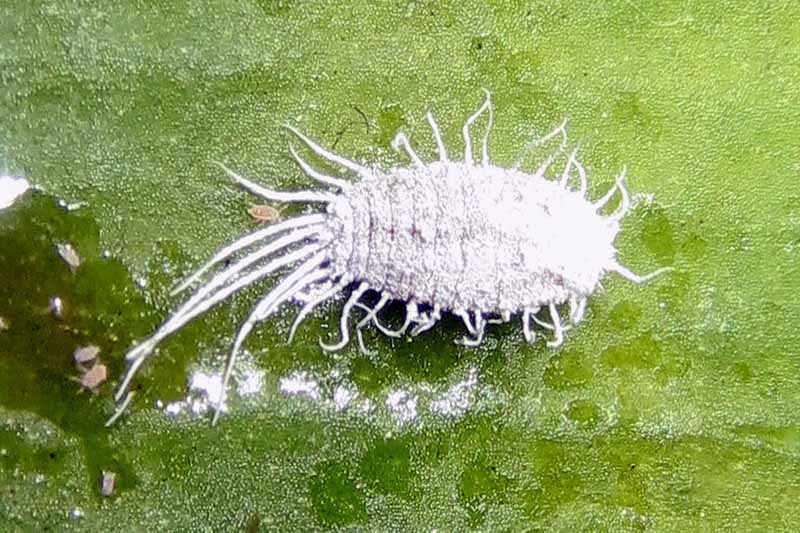
These pests will latch onto your houseplant and suck away valuable nutrients, leaving the plant undernourished. Making matters worse, mealybugs leave deposits of honeydew on the plant, which can lead to fungal problems.
There are many options when dealing with an infestation of mealybugs. Be sure to read our article on mealybugs to learn how to control and eradicate these pests.
Scale
Like mealybugs, scale insects can be hard to spot.
What should you look for? Small, smooth, round or oval-shaped dots on your calathea’s stems or the undersides of their leaves. Scale insects are often brown, but can also be black, tan, beige, or green in color.
Like mealybugs, scale insects suck nutrients from the plant and leave a residue of honeydew behind, raising the risk of fungal infection.
To learn more about identifying and controlling these pests, read our article on scale insects.
Spider Mites
Spider mites are so tiny that it can be easy to overlook a problem until there’s a severe infestation.
These tiny arachnids can cause stippling as they suck nutrients from leaves, and will eventually shroud your houseplant in webbing.
Read our guide to spider mites to learn how to inspect for and control these pests.
Disease
Disease in calatheas is rare and easy to prevent. Here’s what you need to know:
Cucumber Mosaic Virus
Cucumber mosaic virus is a viral pathogen that can cause a yellow mosaic pattern on your houseplant’s leaves.
Since there’s no treatment for this disease, prevention is your best strategy. To prevent introducing pathogens, make sure to wash your hands between handling different specimens, and sanitize your tools.
If your houseplant does succumb to this disease, the good news is that the damage is only cosmetic.
However, to prevent spread to other houseplants in your collection, the safest recourse is to destroy the infected specimen.
Helminthosporium Leaf Spot
Have you noticed any brown or tan lesions on the leaves of your calathea, accompanied by yellow halos? If so, Helminthosporium leaf spot may be to blame.
This disease is caused by various fungal organisms that thrive in wet conditions and mild temperatures.
Prevention is the best route, so avoid wetting your calathea’s leaves while watering, especially on cool days.
Once prevention is no longer an option, infections can be controlled with fungicides, such as the natural, nontoxic fungicide neem oil.

I recommend TheraNeem brand, available for purchase from Organix South via Amazon in 16-ounce bottles.
Make sure to follow the manufacturer’s instructions when applying this product.
Root Rot
If your calathea has yellow leaves or is wilting despite having wet soil, root rot may be to blame.
Root rot is associated with soilborne fungi, which thrive in wet, soggy conditions.
This means root rot is preventable with good watering hygiene: don’t let your houseplant sit in a saucer of water, make sure it’s potted in an appropriately-sized container, and ensure that there is good drainage.
For good drainage you’ll need both holes in the bottom of the pot and a well-draining growing medium, such as the one recommended in the soil section of this article above.
If root rot seems to be the cause of your houseplant’s problems, identify the cause so you can prevent recurrence.
You may need to repot your plant into a smaller nursery pot, change its growing medium, or rein in your watering routine.
While pest and disease problems can cause your calathea to develop yellowing leaves, there are other causes for this discoloration – read our article to learn how to troubleshoot yellow leaves on prayer plants.
Best Uses
Rattlesnake calathea can be used as an ornamental houseplant where you want to draw attention to its beautifully patterned foliage.
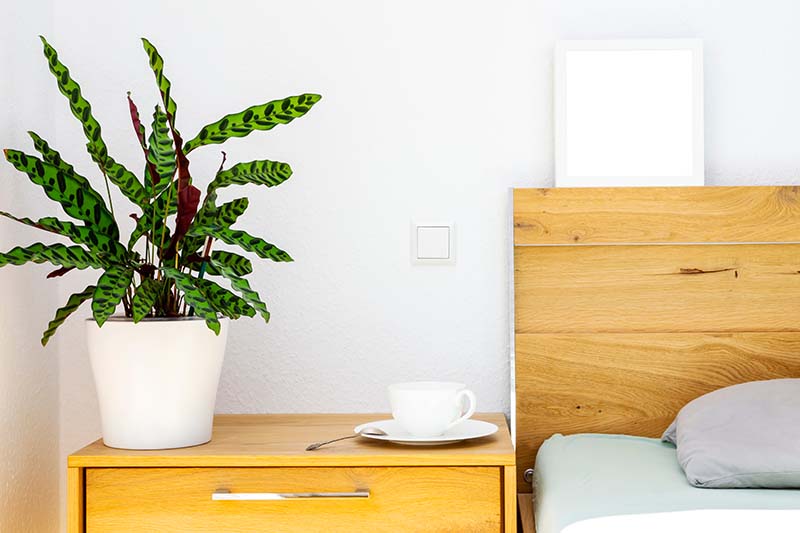
It can work well as a focal point, or grouped with other foliage houseplants in need of some contrast.
This species will also work well for interiorscaping, the type of indoor landscaping used in office buildings or other public spaces.
But its uses don’t end with its good looks!
Since it is considered nontoxic, it can also be used in homes or other spaces where there are children or curious pets present.
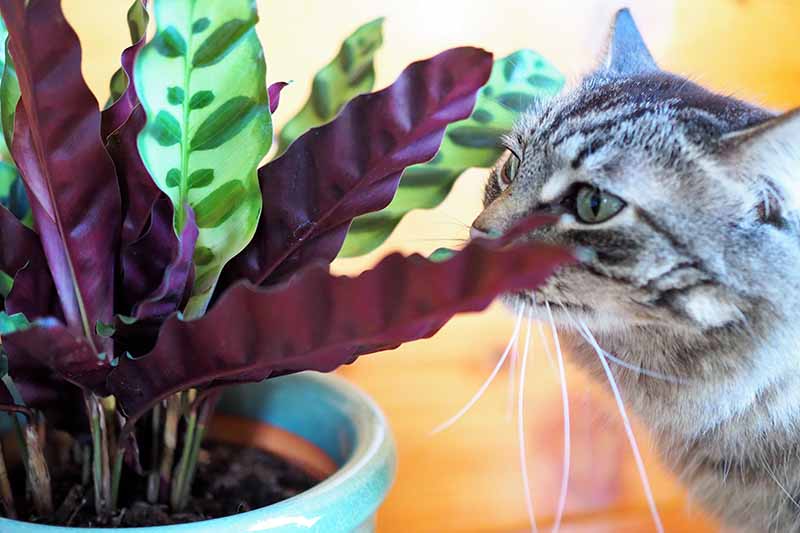
In areas with cold winters, this houseplant should be brought indoors for the winter, but in USDA Hardiness Zone 10a and up it can live outdoors year-round in a location with dappled shade.
Quick Reference Growing Guide
| Plant Type: | Evergreen herbaceous perennial | Flower/Foliage Color: | White/light and dark green with purple undersides |
| Native to: | Brazil | Soil Type: | Peaty, rich |
| Hardiness (USDA Zone): | 10a-12 | Soil pH: | 6.1-7.3 |
| Bloom Time: | Summer | Soil Drainage: | Well draining |
| Exposure: | Medium indirect light | Companion Planting: | Begonia, monstera, orchid, philodendron, pilea, sansevieria, spider plant |
| Height: | 3 feet | Uses: | Ornamental foliage houseplant, outdoor foliage plant in Zone 10a-12 |
| Spread: | 3 feet | Order: | Zingiberales |
| Water Needs: | Medium | Family: | Marantaceae |
| Maintenance: | Moderate | Genus: | Goeppertia (syn. Calathea) |
| Tolerance: | Humidity, low light | Species: | insignis |
| Common Pests: | Aphids, fungus gnats, mealybugs, root knot nematodes, scale, spider mites | Common Diseases: | Cucumber mosaic virus, Helminthosporium leaf spot, Pyricularia leaf spot, root rot |
This Snake Is All Blade and No Bite
While this houseplant is entirely benign, you may, nonetheless, find yourself bitten with desire for this enchanting calathea!
No antidote is required, you now have all the knowledge you’ll need to keep your houseplant happy and healthy.
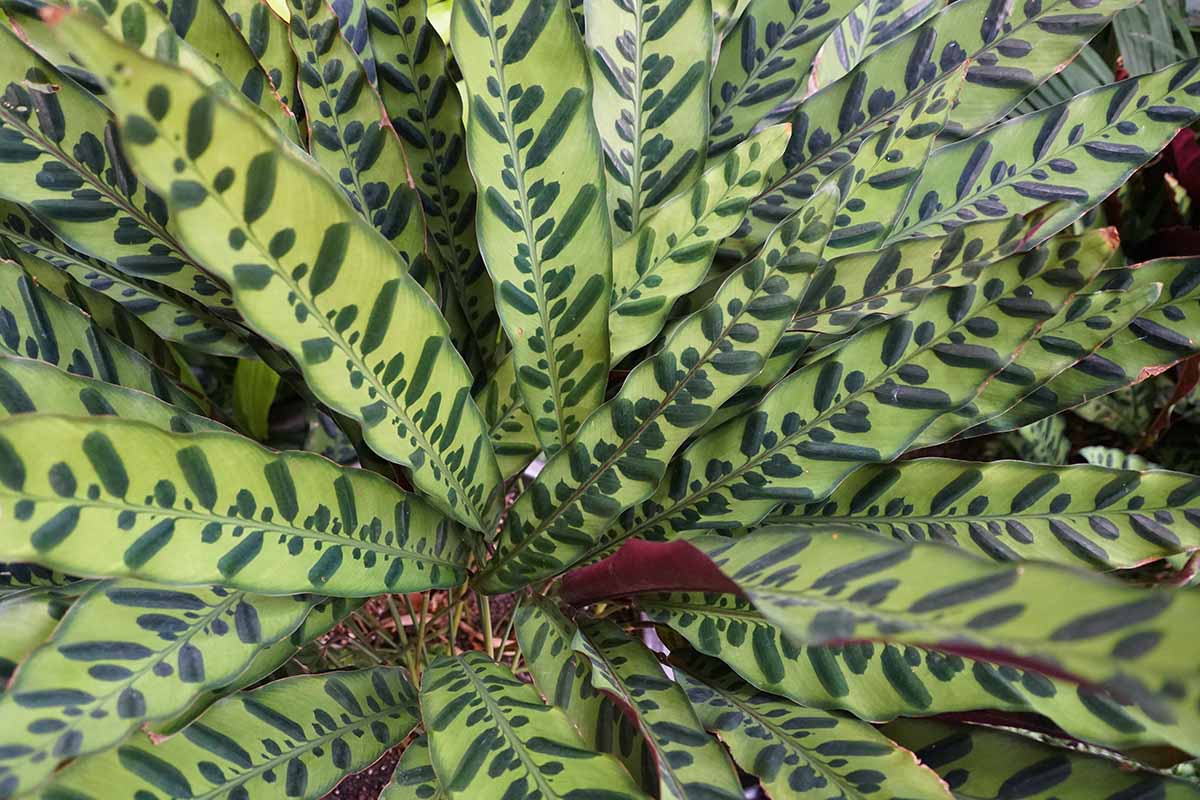
If you’re having any difficulty with your specimen, be sure to drop us a note in the comments section below and we’ll see if we can help you troubleshoot.
And if you have tips of your own that you have used to keep your rattlesnake calathea in tip-top shape, feel free to share them with our readers in the comments section below.
If you’re interested in adding other nontoxic houseplants to your collection, we’ve got more for you right here:
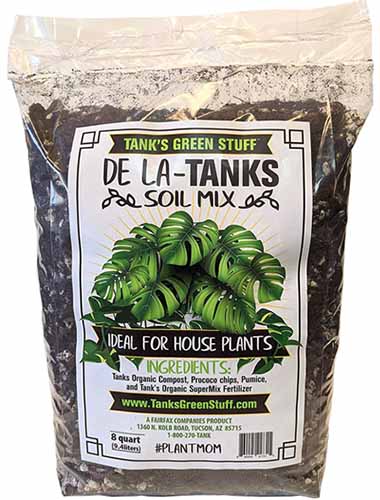
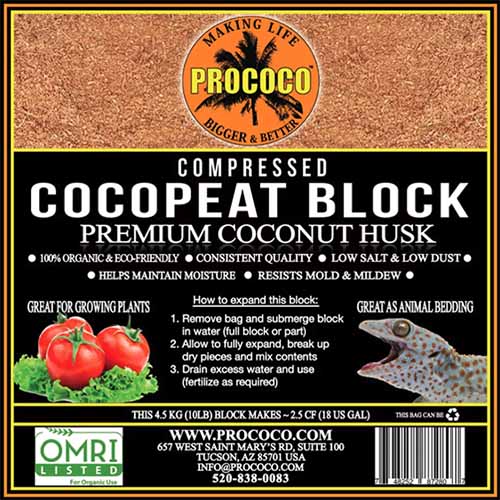
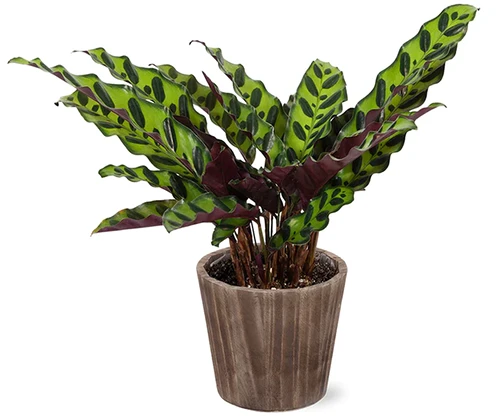
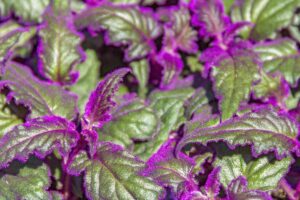
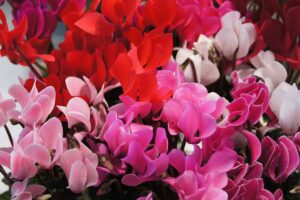
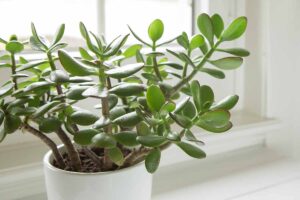
Thanks for the extensive information on the Prayer Plants. I have been collecting them but I find them difficult to manage and was going to throw all out. Your wonderful article prevented that so I will start all over again.
Pearl,
Thanks very much for leaving your comment – I’m thrilled to know that you’re going to give your prayer plants a second chance! Please let us know if we can help you troubleshoot, and best of luck!
Hi, my rattler is wilting (curling is probably a better term) and I repotted it today assuming that root rot is the culprit. Thankfully I came across this article, and if my repotting doesn’t work… I have lots of other tips to sift through to try to keep him alive. Thank you, and I will keep you posted on our progress.
Hi there,
I’m glad you found our article, and I hope the repotting process does indeed help to get your rattlesnake plant back in good health.
If you need any further help, please be sure to post photos to assist us in making a diagnosis, and we’ll be happy to help.
Best of luck!!!
Love the information, very helpful. I have a very large Rattlesnake named “Ava”. She was gifted to me about four years ago, (Ava is a houseplant) and was doing very well for the first two years, but she’s has been having brown spots along leaves, some leaves with yellowing and losing her purple color on the undersides. Help! She is somewhat recovering, new leaves, and I even spotted “flowers” yesterday! She’s not as full as she once was. How how can I keep those problems from recurring? I do water with rain water or distilled water, fertilize during growing season.… Read more »
Hi Natalie, Thanks for leaving your comment and question here – and I’m glad to know you found this article helpful! Is it possible you were a bit late watering once or twice? This has happened to me recently with my zebrina prayer plant. During the winter it only needed water about once every two weeks. But the days started to get warmer, and longer, and suddenly its leaves were getting some brown spots and one leaf turned yellow – it was drying out more quickly with the change in the seasons, and I hadn’t caught up my watering efforts… Read more »
I was surprised to see my indoor Rattlesnake plant had three stems full of flowers! How exciting.
Hi Elisabeth,
Thanks for sharing your good news with us, as well as your photo. I agree, that is super exciting! Enjoy your flowers!!!
What is wrong with this. It’s about 8 years old and has grown so much, until recently. The only thing diffrent is my husband turned a fan on it…
Hi Denice,
As noted in the article, prayer plants really don’t like to have air blowing on them. You might want to try moving it to a draft-free location if you need to use the fan in that area. The leaves that look bad won’t improve, but any new leaves that grow should look better. You can trim off the leaves that look the worst in the meantime.
Hope this helps!